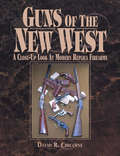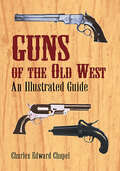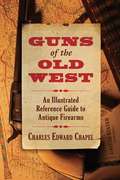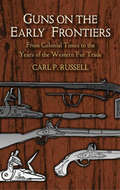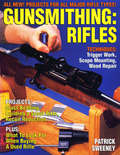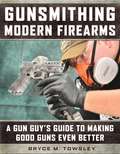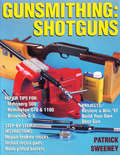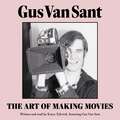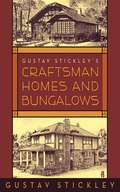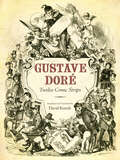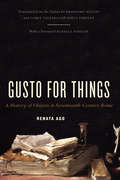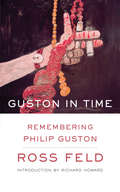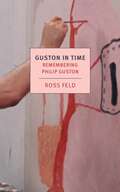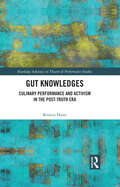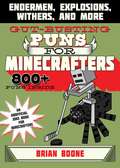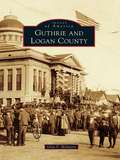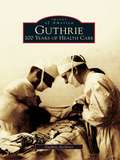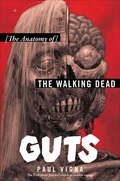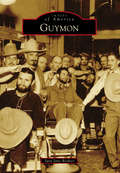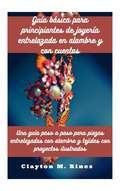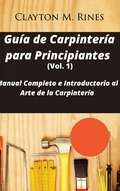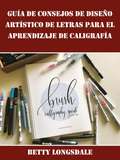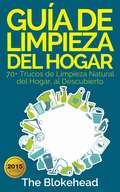- Table View
- List View
Guns of the New West
by David ChicoineRevisit the Classics Choosing the right guns for cowboy competition just got easier. Noted gunsmith and author David Chicoine puts today's most popular replica firearms to the test and shares his findings on the good, the bad and the ugly. Chicoine tests and evaluates handguns, rifles and shotguns in this in-depth yet easy-to-use guide to modern replica firearms. If you love replica guns, this book will help you choose the best.
Guns of the Old West: An Illustrated Guide (Dover Military History, Weapons, Armor)
by Charles Edward ChapelFirearms played an important role on the American frontier. Used to hunt animals for food and clothing, they also safeguarded one’s home against outlaws and other hostile elements. This definitive, scrupulously researched work describes and illustrates the many different weapons that opened up and secured the American West. Enhanced with colorful anecdotes, the vividly detailed narrative tells the dramatic story of shoulder arms, hand guns, percussion and cartridge weapons, and describes the hunters, settlers, peace officers, stagecoach drivers, soldiers, range detectives, rustlers, outlaws, Indian chiefs, and other picturesque characters who used them.Here are detailed descriptions and illustrations of the Kentucky rifle that saw battle in the American Revolution and in the War of 1812; the repeating rifle used in the Civil War; the Sharps rifle that wreaked havoc during the great buffalo hunts; the Colt revolver, used by cowboys and outlaws alike; the fast and reliable Winchester rifle, the most widely used shoulder arm of the post-Civil War era; as well as flintlock pistols, derringers, muskets, buffalo guns, carbines, signal pistols, Confederate revolvers, and many other celebrated firearms.Illustrated with nearly 500 photographs and line illustrations, this classic reference will not only be invaluable to dealers and collectors but will also appeal to Americana devotees, weaponry enthusiasts, and students of the American West.
Guns of the Old West: An Illustrated Reference Guide to Antique Firearms
by Charles Edward ChapelWritten by one of the foremost firearms experts of the twentieth century, Charles Edward Chapel’s Guns of the Old West is an exhaustively researched document that not only boasts a significant collection of antique Western guns, but also categorizes the firearms into easy-to-reference sections.Starting with an introductory chapter on the origins of guns and their earliest uses on the frontier, Chapel covers everything from muskets to rifles, pistols to revolvers, and shotguns to martial arms. Three whole chapters are dedicated to the rise and fall of the famous Deringer pistol. And as much as Guns of the Old West is an encyclopedic reference manual, it’s also fascinating historical literature that frames the world in which these guns were used. Buffalo guns and hunters are covered, along with martial arms of the post–Civil War era. The gun collection of famous collector and hunter President Theodore Roosevelt is given its own chapter.Illustrated with nearly 500 illustrations, as well as important artwork from the Western period from artists such as Frederic Remington, Guns of the Old West is an essential work for gun collectors and American history enthusiasts.
Guns on the Early Frontiers: From Colonial Times to the Years of the Western Fur Trade (Dover Military History, Weapons, Armor Ser.)
by Carl P. RussellThis thoroughly documented, authoritative, and highly readable book not only details the weapons used during the settlement and westward expansion of America but also describes their use by fur traders, trappers, soldiers, and Native Americans. The result is a lively historical examination of the momentous events that were strongly influenced by the gun trade.The text is augmented and enriched throughout with clearly identified illustrations of everything from antique muskets, flintlocks, repeating rifles, and howitzers to bullet molds, powder horns, and other firearm accessories.
Gunsmithing - Rifles
by Patrick SweeneyMake your rifle shoot better than ever! Gunsmithing: Rifles takes a look at all major rifle types and gives you practical information on how to make repairs, improve performance and modify your rifle to fit your needs. In additional to practical information about keeping every rifle ready to shoot, Gunsmithing: Rifles provides specific projects to improve: Mauser actions AR-15s and their clones The Ruger 10/22 The Remington Model 700 The Winchester model 70 Lever-action Rifles Step-by-step instructions and plenty of photos guide you every step of the way. As a practicing gunsmith for the past 20 years, Sweeney also knows enough to tell you what not to try. If an operation requires an expert, he'll tell you. He'll also tell you what questions to ask to help you make sure the person you hire is qualified. If you're in the market for a used rifle, this book also includes tips on getting the most bang for your buck.
Gunsmithing Modern Firearms: A Gun Guy's Guide to Making Good Guns Even Better
by Bryce M. TowsleyOne of America's foremost experts on gunsmithing, Bryce Towsley is back again to provide even more projects for anyone interested in building, customizing, or maintaining firearms. He offers detailed explanations and includes color illustrations for just about every aspect of gun modification and repair. Featured tutorials include: stock modifications, accuracy enhancement, weather preparation, a total rifle makeover, and much more. Beginning with shop design and maintenance, Towsley builds on the knowledge he provides until ending with directions on rifle building from scratch. For anyone interested in fixing or building guns, Towsley’s new book is the best guide to getting the most out of a rifle through personal modifications.“My experience working with Skyhorse is always a positive collaboration. The editors are first-rate professionals, and my books receive top-shelf treatment. I truly appreciate our working relationship and hope it continues for years to come.” –David Fischer, author
Gunsmithing: Shotguns
by Patrick SweeneyImprove your shotgun with tips from a pro! Gunsmithing: Shotguns gives you the information you need to make repairs, improve the performance and adjust the fit of all major shotgun styles. From replacing a missing bead to repairing a malfunctioning action, you learn everything you need with step-by-step instructions. You'll get specific details concerning today's most popular shotguns, including: Mossberg Model 500 Ithaca Model 37 Remington Models 870, 1100 and 11-87 Browning A-5 Winchester Model 1897 and more Easy-to-follow instructions and plenty of photos guide you through every project.
Gus Van Sant: The Art of Making Movies
by Katya TylevichThe first book to talk about the creative process of one of Hollywood's most iconic directorsFrom Drugstore Cowboy to Elephant, Milk and Good Will Hunting, Gus Van Sant's films have captured the imagination of more than one generation. Acclaimed as both an independent and mainstream filmmaker, he is also an artist, photographer and writer. Based on completely new and exclusive interviews, and featuring previously unseen imagery, this book provides a personal insight into how Van Sant successfully approaches these different and varied artforms, providing an inspirational look into the working life of one of America's most pivotal cultural and creative practitioners.
Gus Wagner: Globe Trotter and Hand Tattoo Artist
by Alan GovenarIn 1897, Gus embarked on a four-year career as a merchant seaman. While traveling the world, he discovered the art of tattooing, learning to tattoo from tribesmen in Java and Borneo who showed him how to use traditional handmade tools. By 1901, Gus reportedly had 264 tattoos of his own (and over 800 by 1908), allowing him to promote himself as &“the most artistically marked-up man in America.&” Back home, Gus embarked on a 40-year career as a traveling tattooist, tattooed man, and circus performer. He largely eschewed the new electric tattooing machines that transformed the art form after 1890, and remained faithful to his handheld instruments. With other wandering artists, he carried tattooing inland from coastal ports, making it part of the culture of small-town America in the 20th century. This book includes • more than 100 examples of Gus Wagner&’s tattoo flash as well as photos of his life and work, including his handheld tattooing tools; • excerpts from interviews with Gus, telling his story in his own words; and • selected passages from three of Herman Melville&’s novels—Typee, White Jacket, and Moby Dick, to illuminate the context of the oral history of Gus Wagner; Melville was an astute observer of hand tattoo artists and their clientele. The tattoo flash in this book is a testimony to the richness of Gus Wagner&’s image vocabulary, his life, and his artistic influences. This is the first in a series of three books exploring "the Last of the Hand Tattoo Artists." The next two books will focus on Gus's wife, Maud, and their daughter, Lovetta, renowned hand tattoo artists in their own right.
Gustav Stickley's Craftsman Homes and Bungalows
by Gustav StickleyIn 1901, Gustav Stickley began to create the first uniquely American style of furniture and home design-known as Craftsman. Stickley's principles of home design include construction that is in harmony with its landscape, open floor plans, built-in storage, and natural lighting. He was a major influence on Frank Lloyd Wright, and he remains one of the great names in American architecture. Craftsman Homes and Bungalows showcases his work in an affordable, attractive new edition. Featuring hundreds of black-and-white photographs, line drawings, and sketches of cabins, cottages, and bungalows from concept to finished product, it presents easy-to-understand directions on both home construction and improvement. This resource, a combination of three of Stickley's works, is a comprehensive introduction to the design and building of beautiful Craftsman homes.
Gustave Doré: Twelve Comic Strips
by David KunzleAmong the masters of the nineteenth-century comic strip, Gustave Doré has been much neglected. For his illustrations to literary classics, he earned an unsurpassed reputation and corresponding scholarly attention. Doré himself repudiated his early work, and similarly critics and biographers have given short shrift to his beginnings as a caricaturist. These caricatures are herein rescued entirely for the first time in English by the renowned comics scholar David Kunzle. Doré's caricature is known to a few specialists, but virtually no one has pointed out that his mastery of the comic strip particularly marks him as an entirely original figure in the post-Töpffer era of revolutionary, mid-century France. Doré, remarkably, created these comic strips when he was between fifteen and twenty-two years old, for Charles Philipon's Journal pour Rire (The Laughter Journal), virtually dominating its seven-year (1848-55) history. He also did three fairly long, separately published albums, which show him at his very best. They are consistently funny, often ludicrous, and illustrate a graphic inventiveness unmatched until the twentieth century. In these graphic stories, Doré parodies an ancient fable, the discomforts of life in the country, the perils of artistic ambition, the absurdities of mountaineering and travel, as well as the antics of schoolboys. This book provides a context for Doré's caricatures, focusing on his comic strips in the Journal pour Rire, the character of the journal, and the three comic strip albums he created while he worked there. Kunzle's analysis reveals Doré's debts to his predecessors, Töpffer, Cham, and Nadar. None of Doré's Journal strips has ever been republished. Some of the albums were republished, reduced and incomplete, in German and French. This edition includes facsimiles of the twelve most significant comic strips and the first translation into English of the captions.
Gusto for Things: A History of Objects in Seventeenth-Century Rome
by Renata AgoWe live in a material worldOCoour homes are filled with things, from electronics to curios and hand-me-downs, that disclose as much about us and our aspirations as they do about current trends. But we are not the first: the early modern period was a time of expanding consumption, when objects began to play an important role in defining gender as well as social status. "Gusto for Things" reconstructs the material lives of seventeenth-century Romans, exploring new ways of thinking about the meaning of "things" as a historical phenomenon. aThrough creative use of account books, inventories, wills, and other records, Renata Ago examines early modern attitudes toward possessions, asking what people did with their things, why they wrote about them, and how they passed objects on to their heirs. While some inhabitants of Rome were connoisseurs of the paintings, books, and curiosities that made the city famous, Ago shows that men and women of lesser means also filled their homes with a more modest array of goods. She also discovers the genealogies of certain categories of thingsOCofor instance, books went from being classed as luxury goods to a category all their ownOCoand considers what that reveals about the early modern era. An animated investigation into the relationship between people and the things they buy, "Gusto for Things" paints an illuminating portrait of the meaning of objects in preindustrial Europe. "
Guston in Time: Remembering Philip Guston
by Ross FeldIn the years following his controversial 1970 exhibition at the Marlborough Galleries, Philip Guston was generally viewed as yesterday's scandal, a maverick who had abandoned abstract expressionism and, with it, the adulation of the art world. Few paid serious attention to the disturbing, profound work he was producing in his Woodstock studio. So when Ross Feld, a young novelist and critic, wrote a penetrating review of Guston's latest show, the artist sent him a letter of appreciation: "I felt . . . as if we knew each other and had many discussions about painting and literature. In a word—I felt recognition."Thus began a remarkable friendship. Feld, a frequent visitor to Guston's studio where the two men would talk late into the night, became Guston's intellectual sparring partner and sounding board—"I'll shout it right out," Guston wrote to Feld, "you inspire me to paint again!"—as well as the artist's most eloquent critic and champion. Guston in Time is Feld's final tribute, and it is at once a testament to a friendship, a provocative and richly nuanced study of one of the twentieth century's most important artists, and a portrait of a remarkable character.
Guston in Time: Remembering Philip Guston
by Ross FeldIn this warm and vibrant work of memoir and criticism, a young writer forges a friendship with Philip Guston, one of the most influential and controversial painters of the twentieth century.The late work of Philip Guston has had a profound influence on painters today, but as Guston&’s star has risen, it has been forgotten how scandalous these paintings, with their cartoonish imagery and almost fumbling application of paint, were initially deemed to be. The 1970 show at the Marlborough Gallery in which Guston, abandoning the delicate abstract expressionism for which he was known, revealed his new style, was critically savaged. In the aftermath of this drubbing, he retreated to his studio in Woodstock, New York—in part to nurse his wounds but, more important, to go on painting exactly as he saw fit.Ross Feld, a young poet, novelist, and critic, was one of the rare critics to respond favorably to Guston&’s late work. Guston answered with a grateful note, and a new friendship was soon born. Guston in Time, written not long before Feld&’s early death from cancer, is a portrait of Guston the man; and of his wife, Musa, a major figure not only in his life but in his work; a reckoning with his supremely individual achievement as an artist; and a work of art in its own right.A retrospective of Guston&’s work, Philip Guston Now, will be on view at the Museum of Fine Arts, Boston, from May 1 to September 11, 2022; at the Museum of Fine Arts, Houston, from October 23, 2022, to January 15, 2023; at the National Gallery of Art, Washington, D.C., from February 26 to August 27, 2023; and at the Tate Modern, London, from October 3, 2023 to February 4, 2024.
Gut Knowledges: Culinary Performance and Activism in the Post-Truth Era (Routledge Advances in Theatre & Performance Studies)
by Kristin HuntThis book examines historical and contemporary activist alimentary performance with an eye toward, or perhaps a taste for, what these performance modes can reveal about changing relationships between the senses, truth, justice, and ethical action amid the post-truth era’s destabilization of shared notions of truth. This inquiry emerges in response to an urgent need to understand how multisensory models of knowledge, truth, and justice can be ethically employed to nurture a more just society. Alongside this goal is a drive to understand the ways in which these modes of performance are being co-opted by authoritarians, white supremacists, anti-science activists, and others to shore up injustice, promote misinformation, and anxiously guard existing systems of power and privilege. From white supremacist milk-drinking performances to liberatory uses of culinary performance as pedagogy, Kristin Hunt analyzes both disturbing and inspiring alimentary events to understand how performers, cooks, scholars, artists, and activists can effectively cultivate models of alimentary performance that center plenitude, joy, and justice while pushing back against models rooted in anxiety, diminishment, and cruelty. The text should be of interest for students in performance studies, contemporary theatre, and theatre history as well as courses in food studies and popular culture.
Gut-Busting Puns for Minecrafters: Endermen, Explosions, Withers, and More (Jokes for Minecrafters)
by Brian Boone Amanda BrackIt can’t get punnier than this!
Guthrie and Logan County
by Glen V. McintyreGuthrie and Logan County lie at the geographical center of Oklahoma, just north of Oklahoma City. The bulk of Logan County was opened by the Land Run of April 22, 1889, with the eastern portion opened by the run of September 6, 1891, that opened the Iowa, Sac and Fox, and Potawatomi reservations. The town of Guthrie was the political and cultural center of first the territory of Oklahoma from 1890 to 1907, then the state of Oklahoma until 1910. Guthrie attracted architects who built impressive buildings, businessmen and farmers who hoped to make a new life, and a variety of other characters wanting to make a new home. While Guthrie was the most important town, others thrived as well: Marshall (home of Angie Debo, an important Oklahoma historian), Langston (home of Oklahoma's first black university), Mullhall, Orlando, Crescent, Meridian, and Coyle, as well as many towns that did not survive.
Guthrie: 100 Years of Health Care
by Guthrie ArchivesWhen Dr. Donald Guthrie arrived in Sayre in 1910, it was home to the third-largest railroad repair shop in the world. A small hospital, the first in the region, had opened 25 years earlier to care for those injured in this dangerous work. Fresh from surgical training at the Mayo Clinic, Guthrie brought with him a vision and the energy and charisma to make his dream a reality. He started Guthrie Clinic, one of the oldest multispecialty group practices in the nation, and established Robert Packer Hospital as the region's premier destination for hospital care. Guthrie's reputation as a surgeon grew, and the hospital cared for leaders of business, government, and society alongside the townspeople. Through two world wars, the Great Depression, and a devastating fire-in which no lives were lost-nothing slowed Guthrie's vision, and it has become a lasting legacy. More than 200 photographs tell the remarkable story of the transformation of a small rural hospital into an award-winning integrated health care system.
Guts: The Anatomy of The Walking Dead
by Paul VignaIn this first and only guide to AMC’s exceptional hit series The Walking Dead, the Wall Street Journal’s Walking Dead columnist celebrates the show, its storylines, characters, and development, and examines its popularity and cultural resonance.From its first episode, The Walking Dead took fans in the United States and across the world by storm, becoming the highest-rated series in the history of cable television. After each episode airs, Paul Vigna writes a widely read column in which he breaks down the stories and considers what works and what doesn’t, and tries to discern the small details that will become larger plot points. So how did a basic cable television show based on Robert Kirkman's graphic comic series, set in an apocalyptic dog-eat-dog world filled with flesh-eating zombies and even scarier human beings, become a ratings juggernaut and cultural phenomenon? Why is the show such a massive hit? In this playful yet comprehensive guide, Vigna dissect every aspect of The Walking Dead to assess its extraordinary success.In the vein of Seinfeldia,Vigna digs into the show’s guts, exploring its roots, storyline, relevance for fans and the wider popular culture, and more. He explores how the changing nature of television and media have contributed to the show’s success, and goes deep into the zombie genre, delineating why it’s different from vampires, werewolves, and other monsters. He considers why people have found in zombies a mirror for their own fears, and explains how this connection is important to the show’s popularity. He interviews the cast and crew, who share behind-the-scenes tales, and introduces a cross-section of its diverse and rabid viewership, from fantasy nerds to NFL stars. Guts is a must have for every Walking Dead fan.
Guy Maddin's My Winnipeg
by Darren WershlerGuy Maddin is Canada's most iconoclastic filmmaker. Through his reinvention of half-forgotten film genres, his remobilization of abandoned techniques from the early history of cinema, and his unique editing style, Maddin has created a critically successful body of work that looks like nothing else in Canadian film. My Winnipeg (2008), which Roger Ebert called one of the ten best films of the first decade of the twenty-first century, has consolidated Maddin's international reputation.In this sixth volume of the Canadian Cinema series, Darren Wershler argues that Maddin's use of techniques and media that fall outside of the normal repertoire of contemporary cinema require us to re-examine what we think we know about the documentary genre and even 'film' itself. Through an exploration of My Winnipeg's major thematic concerns - memory, the cultural archive, and how people and objects circulate through the space of the city - Wershler contends that the result is a film that is psychologically and affectively true without being historically accurate.
Guymon (Images of America)
by Sara Jane RichterGuymon, the "Queen City" of the Oklahoma Panhandle, has long been the linchpin of Panhandle commerce, education, and entertainment. As a community of over 12,000 residents, it has seen growth--especially in the past two decades--mainly because of a rise in its immigrant population. With a median family income of $46,000, a low unemployment rate, and nearly 900 businesses, many see it as a thriving and prosperous town. Above all, Guymon knows its past and revels in its history of pioneers who settled the area in the late 1880s amid dugouts and cattle ranches and the railroad. Frontier heritage is clearly reflected in Guymon's spirit of independence, friendliness, and irrepressibility. Guymon, a town older than the state of Oklahoma, is proud of its tenacity and will continue to be the mainstay of the Panhandle for years to come.
Guía básica para principiantes de joyería entrelazada en alambre y con cuentas: Una guía paso a paso para piezas entrelazadas con alambre y tejidas con proyectos ilustrados
by Clayton M. RinesLa creación de piezas de joyería atemporales está ahora a su alcance. El arte de entrelazar con alambre es un proceso sencillo y sin complicaciones que hará que sus piezas de joyería suban un peldaño más hacia una obra maestra. Las cosas más sencillas de la vida suelen ser las más atractivas y hermosas; lo mismo ocurre con las piezas de joyería entrelazadas en alambre. Todo lo que usted necesita es algunas herramientas fáciles de conseguir, cuentas, alambres, y en pocos minutos, usted tendrá una pieza de arte invaluable en sus manos. La sencilla obra que ha creado puede transformarse en algo elegante y sorprendente con la introducción de un nuevo alambre, unos cuantos giros y dobleces, una o dos cuentas de colores brillantes, y ¡voilá! Has conseguido una pieza fascinante. El libro "Guía básica para principiantes de joyería entrelazada en alambre y con cuentas" revela todos los misterios de los materiales de joyería, desde las piedras preciosas hasta los materiales de alambre, los métodos de elaboración, los tipos de metales, los métodos de acabado de las cuentas, los cierres, etc. El libro incluye proyectos increíbles de pulseras, pendientes, colgantes, collares, etc. Otras cosas sorprendentes que aprenderá son Formar complejos diseños con alambre Trabajar con cuentas en alambres y espirales Introducir cuentas en un alambre doblado Configurar bucles entrelazados a ganchos en pendientes y cadenas ¡Y mucho más! Este libro es perfecto tanto para los novatos como para los principiantes, ya que todos los proyectos están bien detallados, paso a paso, y vienen acompañados de ilustraciones para hacerlos más comprensibles. Los abundantes consejos que aparecen en el libro también le ayudarán a crear piezas de joyería de alta calidad que causarán respeto y admiración en cualquier habitación en la que se encuentre el usuario. Los más experimentados descubrirán sin duda toneladas de con
Guía de Carpintería para Principiantes (Vol. 1): Manual Completo e Introductorio al Arte de la Carpintería
by Clayton M. Rines¡Carpintería entretenida para todas las edades! Todos hemos imaginado o probado por nosotros/as mismos/as alguna forma de proyecto de carpintería sin importar cuán simple fue; los resultados no son siempre lo que esperamos. Si usted aun no ha probado ninguna forma de carpintería o si al contrario ha decidido ir en serio hacia este fascinante arte, estará entonces en un rumbo correcto al seguir esta encantadora guía y viaje. Crear algo nuevo y exquisito con habilidades básicas y materiales asequibles es una práctica cuyos orígenes no se pueden rastrear, el cual ha dado felicidad y sensación de completitud a muchos en el pasado. Tristemente, debido a la modernización y la llegada de tecnología este precioso arte gradualmente decae. Si observa de cerca el mundo del arte, verá que las manualidades, especialmente las trabajadas en madera y cueros, han sido las más afectadas. - ¿Cómo comenzar? - Equipo y herramientas que debe obtener y aprender a manejar - Habilidades que necesita desarrollar en el transcurso de horas de práctica - Diseño de su espacio de trabajo - Medidas de seguridad que debe dar a su espacio de trabajo durante las obras - Comience pensando en pequeño para trabajar gradualmente en su nivel de confianza Estas son, en verdad, preguntas comunes que tienen fundamento en el nivel de conocimiento sobre el mundo de la carpintería y cómo estos conocimientos construirán más. Todo estará en este libro, además de mucho más. Además de sus preguntas básicas, hay algunos bloques de construcción vitales que deberá encontrar en las próximas páginas de este impresionante libro. - Fundamentos de carpintería - Tipos de maderas y cómo seleccionar maderas para sus proyectos - Habilidades de carpintería básicas<b
Guía de Consejos de Diseño Artístico de Letras para el Aprendizaje de Caligrafía
by Betty Longsdale Carola Sánchez CuevaEn un tiempo en el que mucho de lo que escribimos está hecho a través de fuentes de computadora, el diseño artístico de letras nos permite ser únicos y expresar nuestro propio estilo. En este libro, Maggie revela la belleza del arte y cómo tú puedes dominar esta forma de arte para expresarte a ti mismo. Aquí está lo que se incluye: -Material necesario -Plumillas -Tinta -Papel -Preparación -Curvas y trazos -Diferentes estilos --> Deslízate al principio de la página y haz click en Añadir al carro para comprarlo instantáneamente Descargo de responsabilidad: Este autor y los propietarios de Copyright no afirman, prometen, o garantizan exactitud, completitud, o adecuación de los contenidos de este libro, y expresamente niegan toda responsabilidad por los errores y omisiones en los contenidos dentro de este. Este producto es solo para uso referencial.
Guía de Limpieza del Hogar
by The BlokeheadLas ideas en este libro representan algunas de las más populares sugerencias de muchos sitios que están dirigidos a empoderar a los propietarios de hogares. Muchos cuidadores de casa han disfrutado estos consejos que les han ahorrado miles de dólares en productos de limpieza y horas de tiempo de trabajo. Este libro está dividido en seis capítulos, cada uno trata sobre una simple sustancia encontrada en tu hogar que puede ser usada en una miríada de aplicaciones de limpieza. Y, como indica el título, Encontrarás más de 70 ideas únicas para ayudarte a que la limpieza sea más fácil. No tienes que salir para comprar algún químico caro o equipo de una tienda departamental. Cada truco de este libro puede hacerse con cosas que se encuentran en tu cocina y baño. Puede que ya tengas todos estos artículos en casa sin saber cuán útiles son. Esa es la belleza de los trucos. No tienes que gastar mucho para tener la misma calidad de trabajo que las sustancias pueden lograr.
